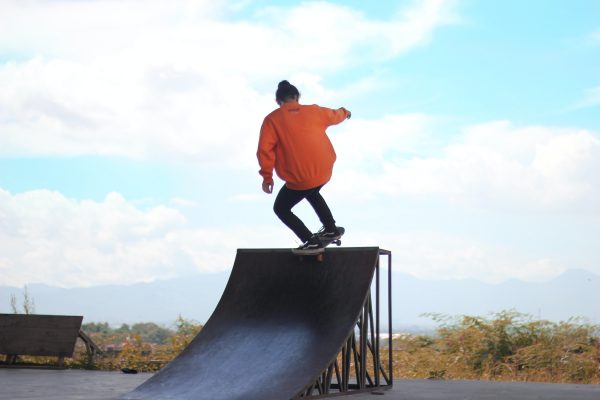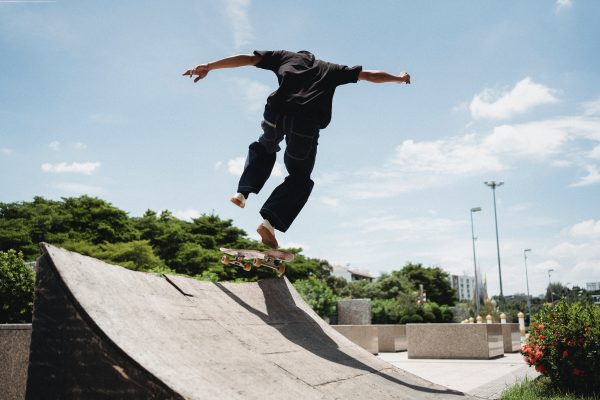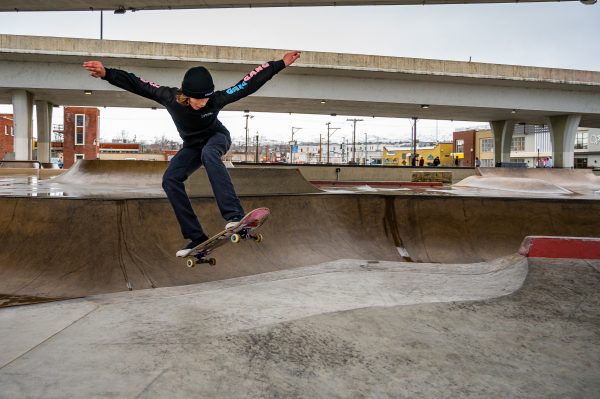Do you want to create your own longboard obstacles for practice? Specifically, making your skateboarding DIY ramp. Are you a passionate skateboarder yearning to take riding to new heights through a ramp?

Are you eager to challenge yourself and make a do-it-yourself thrilling longboard ramp but don’t know how to do it? This is the right article if you’re seeking to build a skate ramp.
Look no further! We’ve got the ultimate solution for you – build your do-it-yourself longboard ramp with this comprehensive guide!
In this article, we’ll take you on a captivating journey as we dive into the world of do-it-yourself skateboard ramps specifically designed for DIY skate beginners like you. Whether you’re just starting out or seeking to improve your skills, constructing a mini ramp DIY in your backyard can be exhilarating and rewarding, especially when armed with the right plans.
From choosing the right materials to crafting the perfect slope, we’ll guide you through each process step, ensuring you have all the knowledge and confidence needed to construct a safe and enjoyable mini ramp DIY. Our guidelines will be very helpful if you’re specifically interested in a mini ramp DIY. So, grab your tools, put on your creative cap, and get ready to own the slope!
But first, let’s explore the reasons why building your do-it-yourself mini ramp (or even DIY halfpipe)is an adventure worth undertaking. Whether it’s the freedom to skate whenever you want, the satisfaction of creating something with your own hands, or the endless possibilities to master different tricks using features like a grind rail, there’s a world of excitement waiting for you. Consider adding a launch ramp to your setup for an even greater thrill.
So, gear up, unleash your inner builder, and let’s embark on this thrilling journey of transforming your ordinary skating routine into an extraordinary one—right in your own backyard! Experience the transition of joy of cruising down your custom-built mini ramp DIY and unveiling a whole new dimension to your skateboard riding passion. Make this one of your best projects.
Skate Takeaways
- Building a DIY skateboard ramp can be a rewarding project for beginners.
- Proper planning and design are essential to create a safe and enjoyable ramp.
- Choose quality materials and assemble a sturdy frame for stability.
- Thoroughly inspect the ramp for safety hazards before and after construction.
- Regular maintenance and prompt repairs are crucial for a safe riding experience.
- Always wear appropriate safety gear, such as a helmet, knee pads, elbow pads, and wrist guards.
- Respect your skill level and avoid attempting tricks beyond your abilities.
- Invite friends and fellow skateboarders to share the excitement and foster a supportive community.
- Embrace the joy of skateboard riding while staying cautious and responsible.
- Celebrate your progress and enjoy the journey of self-expression and personal growth.
DIY Longboard Ramp
Building a do-it-yourself longboard ramp, also known as a skate ramp or longboard ramp, can be a fun and rewarding project for beginners. Before making a do-it-yourself ramp for a longboard, spend time outdoors, raise considerations, measure the area, draw the design, and consider the necessary measurements. Here’s a simple step guide to help you build a skate ramp and create your own slope-style skateboard ramp:

Materials You Need For Ramp-Making
- 1. Plywood sheets (preferably 3/4 inch thick, marine-grade if possible)
2. 2×4 wooden studs
3. Screws (2.5 inches or longer)
4. DIY Skateboard ramp plans or design (you can find some online or create your own)
5. Circular saw or jigsaw
6. Drill and drill bit or bits
7. Measuring tape
8. Pencil or marker
9. Safety gear (gloves, goggles, ear protection)
10. Level
Guide On Making DIY Skate Ramp
- Plan and Design: Start by sketching out your skateboarding DIY skateboard ramp design on paper or using design software. Decide on the dimensions, slope angle, and other details like the height and width of the ramp step. Ensure enough space in your yard or driveway to accommodate the inclined surface.
- Gather Materials: Purchase the required materials for the skateboarding DIY skate project, including the plywood sheets, 2×4 wooden studs, pieces of screws, and other tools listed above. Make sure the plywood is of good quality and free from any defects.
- Cut the Frame: Cut the wooden studs to the desired length for the skateboarding DIY mini ramp’s frame bottom support. Use a circular saw or jigsaw to make the cuts accurately. Assemble the frame according to your design, ensuring everything is level and square.
- Cut the Plywood: Cut the plywood sheets to match the size and shape of each skateboarding DIY inclined surface section. Use your design as a guide to ensure precise cuts. Take safety precautions while cutting, and wear appropriate gear.
- Attach Plywood to Frame: Lay the plywood pieces on top of the frame and secure them using screws. Place screws at regular intervals to ensure a strong and stable skateboarding DIY skate ramp surface.
- Build the Slope: For a beginner-friendly slope, aim for a moderate angle that is not too steep. A gradual incline will be more forgiving for learning skateboarding tricks. Attach the sections of the skateboarding sides of the ramp together securely using screws.
- Add Coping (Optional): If you want to add coping (a metal or PVC edge) to the top of the DIY skateboard ramp inclined surface for grinds and slides, you can do so at this stage.
- Check for Stability: Double-check that all the components are securely attached and the sides of the ramp step are stable. Make any necessary adjustments before using it.
- Paint or Seal: Consider painting the surface with skateboard-specific paint or seal it with a weather-resistant sealant to protect it from the elements. The paint is important.
- Test and Enjoy: With your DIY skate ramp complete, give it a test run with your skateboard. Always wear appropriate safety gear when skateboarding on the ramp, such as a helmet and knee and elbow pads, when skating on the DIY skateboard ramp.
Lastly, remember to drill a hole using a drill bit through the top layer or the top of the ramp of the two sheets of flat steel for added support and screw them underneath to create a do-it-yourself ramp stand for better ground service.
Ensure the coping on the DIY ramp withstands wear and tear by sourcing a durable steel pipe from the local hardware store. Securely anchor the steel pipe to both sides of the ramp step to maintain stability during skate tricks. After installing the steel pipe, test the ramp by grinding along it to verify there is no movement or instability.
Skateboard riding can be risky, especially on home DIY ramps, so take safety seriously. This ramp is intended for beginners who are using their longboard but always use it responsibly and within your skill level. As you become more experienced, you may want to tackle more complex inclined surface designs or add features like rails and boxes to challenge yourself further. Consider consulting some inclined surface plans to ensure a safe and challenging setup when contemplating your next project.
Making DIY Halfpipe
To start building your new halfpipe, the first step is to choose the right size and type of wood. Plywood and lumber are essential materials and can be purchased at local hardware stores. For a smooth transition surface, you’ll need 2×4 wooden studs for the frame and masonite sheets. Before assembly, cut the wood sheet to the required dimensions and prepare to drill holes where the screws will go. Use a steel tape measure to ensure all pieces are level and correctly aligned on every side and bottom. The top of the ramp or top layer of plywood should be secured with screws to create a durable riding surface. For further guidance, watch a YouTube video on constructing ramps, focusing on how to screw the layers together and maintain a uniform quarter pipe curve.
Checking For Safety Hazards On Skateboard Ramp
Ensuring safety is paramount when building and using a longboard-inclined surface. Before you start construction and each time before you skate on the inclined surface, it’s crucial to check for potential safety hazards thoroughly. Here are some essential safety checks:
1. Stability and Structure: Inspect the entire inclined surface for stability. Check that all joints and connections are secure and that there are no loose or wobbly parts. Ensure the frame is well-built and capable of supporting the weight of riders. Give it a check!
2. Smooth Surface: Ensure the plywood surface is smooth and free from any splinters, cracks, or holes that could cause accidents. Sand down rough edges or surfaces of the plywood to create a safe riding area.
3. Proper Fastening: Verify that all screws are tightly secured and flush with the surface. Loose screws can lead to accidents and injuries.
4. Coping and Edges: If your ramp has coping (metal or PVC edge), ensure it is securely attached and has no sharp edges or protruding parts that could cause harm during grinds and slides.
5. Slope Angle: If the ramp has a slope, ensure it is appropriate for beginners and within your skill level. Avoid extremely steep angles that could lead to loss of control.
6. Obstacles and Debris: Check the surrounding area for any obstacles or debris that could interfere with your skating or pose tripping hazards.
7. Weather Conditions: Before skating, assess weather conditions. Rain, snow, or wet ground surfaces can make the inclined surface slippery and dangerous. Avoid using the ramp step in adverse weather conditions.
8. Safety Gear: Always wear appropriate safety gear, including helmets, knee pads, elbow pads, and wrist guards. Protective gear can minimize the impact of falls and prevent serious injuries.
9. Supervision and Skill Level: Beginners should have adult supervision while using the inclined surface, especially if they are young or inexperienced riders. Skaters should know their skill level and avoid attempting tricks beyond their abilities.
10. Rules and Guidelines: Establish rules for using the ramp and communicate them clearly to all users. Encourage safe longboard riding practices and respect for others sharing the space.
11. Maintenance: Regularly inspect and maintain the inclined surface. Fix any damages or issues promptly to ensure the inclined surface remains safe to use over time.
Remember, longboard riding involves inherent risks, and accidents can happen even with all safety precautions in place. Being mindful of your abilities and limitations while using the ramp is crucial.
Checking for safety hazards each time and a DIY map on a do-it-yourself longboard inclined surface is important to ensure proper support, measure dimensions accurately, prevent moisture damage, account for outdoor conditions, consider neighbors, and avoid potential hazards that could affect the ramp’s stability, especially when using materials like masonite, making it a safe and enjoyable space for skating.
If you’re a beginner, consider seeking advice from more experienced riders or builders to ensure your inclined surface is safe and suitable for your skill level. Always prioritize safety to maximize your longboard riding experience while reducing the likelihood of injuries.
Conclusion
Building your own longboard ramp can be a thrilling and rewarding endeavor for beginners. By following the steps outlined in this article and conducting thorough safety checks, you can create a safe and enjoyable space to hone your longboard riding skills right in your backyard.

Throughout this journey, you’ve learned the importance of proper planning and design, choosing quality materials, and assembling a sturdy frame. Constructing a smooth and stable surface will enhance your longboard riding experience and contribute to your safety on the inclined surface.
Remember, safety is paramount in longboard riding. Regularly inspect the ramp for any potential hazards, ensure all components are secure, and maintain a smooth riding surface. Always wear appropriate safety gear to protect yourself from potential injuries and encourage others to do the same.
As you progress in your longboard riding journey, your custom-made ramp step will become a hub of creativity where you can challenge yourself, experiment with tricks, and enjoy countless hours of exhilarating rides. Embrace the freedom and joy of longboard riding while constantly pushing your limits, but remember to stay cautious and respect your skill level.
Lastly, share the excitement with fellow riders and friends. Invite them to join you on this thrilling journey and introduce them to the world of do-it-yourself longboard inclined surfaces as they build their own board based on their preference. You can create a supportive and inspiring community that celebrates skateboard riding and encourages each other to improve.
Frequently Asked Questions (FAQs):
Last Updated on July 4, 2024 by Allen Laconsay
DISCLAIMER (IMPORTANT): This information (including all text, images, audio, or other formats on FamilyHype.com) is not intended to be a substitute for informed professional advice, diagnosis, endorsement or treatment. You should not take any action or avoid taking action without consulting a qualified professional. Always seek the advice of your physician or other qualified health provider with any questions about medical conditions. Do not disregard professional medical advice or delay seeking advice or treatment because of something you have read here a FamilyHype.com.